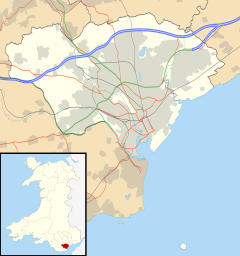Radyr
Radyr
| |
|---|---|
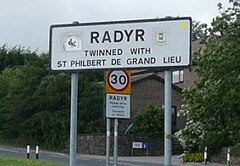 Radyr street sign | |
Location withinCardiff | |
| OS grid reference | ST1380 |
| Community | |
| Principal area | |
| Preserved county | |
| Country | Wales |
| Sovereign state | United Kingdom |
| Post town | Cardiff |
| Postcode district | CF15 |
| Dialling code | 029 |
| Police | South Wales |
| Fire | South Wales |
| Ambulance | Welsh |
| UK Parliament | |
| Senedd Cymru – Welsh Parliament | |
Radyr(Welsh:Radur;Welsh pronunciation:[ˈradɪr]) is an outersuburbofCardiff,about 4 miles (6.4 km) northwest ofCardiff city centre.Radyr is part ofRadyr and MorganstownCommunity,for which the2011 Censusrecorded a population of 6,417.[1]
Morganstownis north of Radyr, on the other side of theM4 Motorway.Neighbouring communities areWhitchurchto the east on the opposite bank of theRiver Taff,Pentyrchto the west withSt FagansandLlandaffto the south.
History
[edit]Stone Age until the Norman Conquest
[edit]Evidence ofStone Ageoccupation of the Lesser Garth Cave near Morganstown was discovered in 1912 and included worked flints.[2]In 1916 excavation of a mound of 30 metres (100 ft) inRadyr Woodsrevealed charcoal andIron Agepottery.[3]Radyr developed after theNorman invasion of Walesat the start of the 12th century and formed part of the Welsh Lordship orcantrefofMiskinunder the Lordship ofGlamorgancreated by the Norman King,William Rufus,in 1093.[3]
Origin of the name
[edit]Hints about the derivation of the nameRadyrcan be found inLifris's writingsLife of St Cadog,written between 1081 and 1104 but relating to the earlier period around AD 530, which mentions a croft ortrefon the site calledAradur Hen.Lifris also tells the story ofTylyway,ahermitwho was held to have lived on the banks of the Taff. Tylyway's cell is the most likely origin of the name Radyr; from the Welshyr adur,meaning "thechantry",althoughArudur Henis also possible.[3]
Norman occupation and Middle Ages
[edit]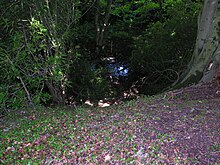
The Normanmottein the "mound field" is a flat-topped mound 30 metres (100 ft) in diameter at the base and 3.8 metres (12 ft) high, surrounded by a ditch 7 metres (23 ft) wide. An adjoiningbaileyto east of the motte could indicate the boundary between Norman and Welsh land.[4]The motte was surrounded by a timberpalisadearound a woodenkeepand formed part of a defensive line with similar mottes atThornhilland Whitchurch.[3]The early settlement that became Radyr developed around the Norman church and manor house in what is nowDanescourt.Surveys in 1307 describe an agricultural hamlet surrounded byarablefields.[3]The 14th century Welsh Lord of Radyr, Cynwrig ap Hywel, followed by his descendants, farmed the area until it was devastated by theBlack Deathand by battles between theMarcher Lordsin 14th and 15th centuries when the whole area was laid waste.[3]
Mathew family
[edit]
In 1469 Thomas Mathew (died 1469), the third or fourth son ofSir David Mathew(died 1484) ofLlandaf,[6]inherited the land by marriage to Catherine, heiress of Radyr, and built Radyr Court, amanor houseon the site of what is now the Radyr Court Inn in Danescourt.[3]The house was used as a court. Although it was destroyed by a fire in the 19th century, the three largedungeonssurvived and can still be seen at the Inn.[7]On Thomas' death, his lands passed to his eldest son David and then to his younger son William Mathew (died 1528), who wasknightedby KingHenry VIIat theBattle of Bosworthin 1485.[3]Sir William accompaniedHenry VIIIto theField of the Cloth of Goldin 1520. His successor was his eldest son Sir George Mathew, who becameMPforGlamorganshireand in 1545Sheriff of Glamorgan.[3][8]
Sir George created adeer parkthat ranged far north of Radyr. Tenant farmers there were evicted, and the loss of rental income contributed to the decline in the family's fortunes.[3]He had 24 children, eight of whom were illegitimate. Many were daughters, and Sir George needed large sums of money for theirdowries.[3]On his death Sir George's lands passed to his eldest son William, who also became an MP and invested in thePentyrchironworks.[3]This was an astute move asfeudalismwas giving way to earlyindustrialisation.William's descendants inherited a diminishing fortune. Captain George Mathew, the last of the family to live in Radyr, married Elizabeth Poyntz, and the couple left Radyr to live on her estates atThurlesinCounty Tipperary,Irelandin 1625.[9]
Stuart period
[edit]Radyr's new owner was a wealthy landowner, Sir Edward Lewis,[10]who was knighted byJames I.Sir Edward ownedSt Fagans Castleand its surrounding lands,[11]scene of theBattle of St Fagansin theEnglish Civil War.The Lewis fortune passed to Elizabeth Lewis, who married Other Windsor [sic], 3rdEarl of Plymouth,the principal landowner in Cardiff, Penarth andBarry.[3]
A survey in 1766 shows that the Plymouth family owned the freeholds of most of Radyr. It continues to do so today. Plymouth Estates sold 22 acres (9 ha) of residential land in Radyr in 2007.[12]
Development from the 18th century
[edit]Many residents of Radyr worked in theMelingriffith Tin Plate Works,on the other side of the River Taff in Whitchurch.[13]The works opened in 1749 and closed in 1957.[14]
Samuel Lewis' 1849Topographical Dictionary of Walessays of Radyr:[15]
"A parish, in the poorlaw union of Cardiff, hundred of Kibbor, county of Glamorgan, in South Wales, 3½ miles (N. W. by W.) from Cardiff; containing 279 inhabitants. This parish probably derives its name, signifying" a cataract, "from the rushing waters of the river Tâf, by which it is bounded on the north-east. It was formerly comprehended within the hundred of Miskin, but has been recently separated therefrom. It comprises about eleven hundred acres of arable and pasture land, inclosed and in a profitable state of cultivation: the surface is in some parts elevated, and in others flat, but no where subject to inundation; the soil is a strong brown earth, favourable to the production of good crops of grain of all kinds, potatoes, and hay. The substratum is partly a hard brown stone, and partly limestone of very good quality. Radyr Court, formerly the seat of the family of Matthew, ancestors of the late Lord Llandaf, has been partially taken down, and the remainder has been modernised, and converted into a farmhouse. The turnpike-road leading from Cardiff to Llantrissent passes a little to the south of the parish; and the Tâf-Vale railway runs through it, nearly parallel with the river, which is crossed by the line in this vicinity. Some of the inhabitants are employed at the iron-works in the parish of Pentyrch.
The living is a vicarage, endowed with £200 royal bounty; patron and impropriator, the representative of the late Earl of Plymouth, who is lord of the manor: the tithes have been commuted for £113. 9s. 0d, of which a sum of £38. 9s. 0d is payable to the impropriator, and a sum of £75 to the vicar. The church, dedicated to St. John the Baptist, is a neat plain edifice, with a curious turret at the west end. There is a place of worship for Calvinistic Methodists; a Sunday school for gratuitous instruction is held in it, and another at Radyr Court. In the parish is a spring of very cold water, called Y Pistyll Goleu, "the bright water-spout," issuing from the side of a hill, under a considerable depth of earth over a limestone rock: it has by some writers been termed mineral, but it is not known to possess any other properties than that of its extreme coldness, which renders it efficacious in curing sprains and weakness of the sinews. "
Until the mid 19th century Radyr was a collection of small farms, crofts and cottages, but afterRadyr railway stationopened in 1863,[16]the population rose from 400 to more than 600 in 20 years.[17]TheTaff Vale Railwayand its successor, theGreat Western Railway,brought significant employment to Radyr. Junction Terrace (the first street in Radyr) was built to house the railway workers. It was the start of strong demand for housing in Radyr that transformed the hamlet.[3]TheBarry Railway'sWalnut Tree Viaduct,built in 1901, dominated the village for some 70 years.
Wartime
[edit]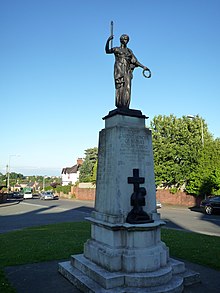
In theFirst World Warthe community raised funds for a "Radyr bed" at the nearby Welsh Metropolitan Military Hospital inWhitchurchand established a "Citizen Guard" made up of those too old or too young to enlist.[3]Losses suffered by the village are recorded on the War Memorial in Heol Isaf.
In theSecond World Warthousands of children were evacuated from metropolitan areas such asLondon,BirminghamandLiverpool.One evacuee fromWoolwich,Patricia Armstrong aged nine, was knocked down by a passenger train and killed on a Saturday afternoon in May 1943 while using the Gelynis foot crossing at Morganstown. She was lodged with a family in Morganstown.[18]Asair raids on Cardiffincreased, even younger children from Radyr were evacuated to boarding schools at Rhoose and Bridgend.[19]
Post-war history
[edit]An extensive housebuilding programme started in the 1960s, and Radyr's population grew rapidly — particularly children. In 1964 Radyr Comprehensive School had 135 pupils on its roll. This number more than trebled in the next decade.[3]A new development, theDanescourtestate, was built on land surrounding Radyr Court and St John the Baptist parish church, and the land was officially incorporated as a suburb of Cardiff in 1974.[20]Danybryn Woods, near the development, was retained as the entire forest is protected by atree preservation orderand is home to many species of plants and wildlife.[21]Radyr railway station was renovated in 1998 and the tracks through the station were renewed, reducing journey times to Cardiff city centre.[20]
In 2017 construction started on the first phase of a new Cardiff suburb of 7,000 houses, namedPlasdwr,on countryside along the Llantrisant Road between Radyr and St Fagans.[22]
Governance
[edit]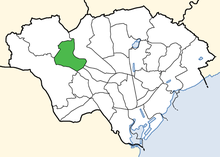
UK Parliament and Senedd
[edit]Radyr is in theCardiff Westparliamentary constituency and theCardiff WestSeneddconstituency.
Cardiff Council
[edit]Radyrelectoral ward(often known as Radyr and Morganstown) has one seat on Cardiff Council and had an electorate of 4,368 (1 May 2008). The ward elected aConservative,Roderick McKerlich, inthe election of May 2008and he was re-elected in 2012 and 2017. Cllr McKerlich is a member of the Council's Environmental Scrutiny Committee.[23]
Community Council
[edit]Radyr and MorganstownCommunity Council is funded by an addition to theCouncil Taxbill paid by local residents.[24]The Community Council is run by 11 elected councillors from three wards in the parish – Radyr North (4 seats), Radyr South (3 seats) and Morganstown (4 seats)[25]- subsequently increased to 12 councillors (4:4:4).
Geography
[edit]Geological structure
[edit]The surrounding soils are mostly a strong, brown, dry earth, well adapted for arable farming and the growing of grains of all kinds that contributed to the area being a mostly farming community until the modern era. Soils were further enriched over the millennia byalluvial depositsfrom the River Taff. Thebedrockunder the whole area is predominantlysandstone,dating from both theDevonianperiod (Old Red Sandstone) and theTriassic(New Red Sandstone) laid down in arid conditions.[26]These may subsequently have been ground down by the Taff valleyglacierduring the lastice agearound 18,000 years ago.[3]Radyr Stone is a Triassicbrecciaused widely for decorative work in the Cardiff area, includingLlandaff Cathedral,Cardiff Docksand in the bridges of theTaff Vale Railway.[27]
Radyr Weir
[edit]
TheRiver Taffat this point runs roughly south throughTaff's Well,past Radyr and throughLlandaff.
Radyr Weir was built in 1774 to divert water into aleatto the Melingriffith Tin Plate Works.[3]The weir is the third obstacle to migratorysalmonandsea trout— the others being Llandaff Weir and Blackweir, both of which also have fish passes.[28]Since the early 1980s, the salmon and sea trout stocks in the Taff have been recovering from nearly 200 years of industrial pollution and exploitation.[29]In 1993 theNational Rivers Authoritymonitored over 500 salmon and 700 sea trout returning to the river to spawn.[30]
From 1749, iron fromPentyrchwas initially transported to the works using pack-horses, thentub boatswere used on the Taff passing onto the feeder via a lock at Radyr Weir. Parts of this lock can still be seen beside the feeder sluice. In 1815 the tub boats were discontinued and a tramway built along the Taff.[30]There is a public picnic site by the Radyr weir.

A hydro-electric scheme was built in 2016 onRadyr Weirto generate renewable energy. The Radyr Weir scheme channels more than 500 million cubic metres of water per year through twoscrew turbinesand is expected to generate 400 kW — enough energy to power three of the city’s leisure centres — which will save 700 tonnes of CO2annually.[31][32]
The River Taff through Radyr is flanked on both sides by an undeveloped greenway that passes uninterrupted through northern Cardiff all the way toCardiff Castlein the centre of the city, before the river entersCardiff Bay.
Radyr Woods Nature Area
[edit]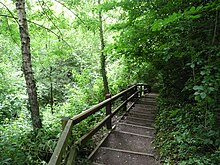
Radyr Woods is aSite of Importance for Nature Conservation(SINC), under the name Radyr Community Woodlands,[33]covering 15.6 acres (6 ha), and the adjoining Hermit Woods is the smallestLocal Nature Reserve(LNR) in Wales, at 1.47 acres (1 ha)).[34][35]The Community Woodlands have a network of footpaths and boardwalks and includes evidence of Iron Age settlements and remains of an early cooking hearth. Originally part of the Tudor deer park owned by the Mathew family and later Radyr Quarry, the area is owned byCardiff Counciland Plymouth Estates, and managed by the Radyr community council with the support of Cardiff Council's Parks Service.[36]
Radyr Woods provides habitats for a wide range of species. It also has a number of natural springs that feed a duck pond and akingfisherpond. Recent housing developments between the reserve and the railway line have added complementary public open space with picnic areas and a children's play area. Since 1986 all maintenance and development of the reserve has been carried out by a volunteer group known as The Friends of Radyr Woods.[37]
Radyr hawkweed
[edit]Radyr hawkweed is the common name ofHieracium radyrense,a very rareendemicmember of theaster, daisy, or sunflower family.It is amicrospecies,so far only identified at Radyr. It was first identified in 1907 at the quarry, was described as a variety in 1948 and then as a separate species in 1955. It has rarely been seen and regular surveys between 1998 and 2004 indicate that today only a single population of about 25 plants survives in the wild.[38]

In the first survey of 1998, only nine plants were identified in one single Radyr garden, where it traditionally grew on grassy banks and lawns, often in shade. It was no longer found at the original locality of Radyr Quarry where examples were last seen in 1985. AtBridgend,six possible plants of the Radyr genus were found on an old garden wall, but confirmation of identification is still awaited.[39]
Neither the species nor the sites have any current legal protection, and it could be under significant threat of survival in the long term from inappropriate gardening or care.[38]Seed samples of the Radyr hawkweed have been provided to theMillennium Seed Bank,the internationalconservationproject coordinated by theRoyal Botanic Gardens, Kew,and plants are being carefully cultivated.[38]The plant normally flowers between May and early July and Radyr residents are urged by botanists to be on the look out for further examples of the endangered species while walking in the area.
Demography
[edit]| Year | Population of Radyr | Change |
|---|---|---|
| 1801 | 196 | – |
| 1811 | 106 | -46% |
| 1821 | 128 | 21% |
| 1831 | 227 | 77% |
| 1841 | 279 | 23% |
| 1851 | 417 | 50% |
| 1881 | 519 | 24% |
| 1891 | 610 | 18% |
| 1901 | 816 | 34% |
| 1911 | 1,238 | 52% |
| 1921 | 1,634 | 32% |
| 1931 | 1,586 | -3% |
| 1951 | 1,568 | -1% |
| 1961 | 1,690 | 8% |
| 2001 | 4,658 | 176% |
| 2009 | 6,000 | 29% * |
| source:Vision of Britainexcept *, which is estimated by theOffice for National Statistics.Historical populations are calculated with the modern boundaries | ||
The 2001 census showed that the suburb had a total population of 4,658, of whom 2,268 were male and 2,390 were female. The average age was 39.7 years. 68.27% of [adult] residents are married, with 20.81% having never married. 73.97% declared their religion asChristianity.23.97% stated no religion and 0.9% statedMuslim.96.02% stated theirethnicityas white, 1.76% asAsian,1.03% as mixed race, 1.01% asChinese,and 0.2% as Black. 15.5% areWelsh languagespeakers.[40]
Landmark buildings and local attractions
[edit]Danybryn Cheshire Home was once a private house owned by Sir Lewis LougherMP.[13]It later had two wings added to accommodate the residents, who are physically disabled young people. The Thatch, the only thatched cottage in Radyr, was built for the Mathias family in 1936.[13]St John the Baptist parish church is nearly 800 years old, but underwent aVictorian restorationin the 19th century.[41]
TheTaff Trailcycle pathpasses through Radyr via Radyr Weir.[42]Other notable buildings include The Old Church Rooms and Radyr War Memorial.[43][44]In nearby districts areSt Fagans National History Museum(formerly the Museum of Welsh Life) andCastell Coch.
Education
[edit]The Church Rooms in Park Road were also a primary school until 1896 when the Board School was opened next door. Older pupils had to travel to secondary schools inPenarthby train.[3]The part-timeRadyr Libraryserves the area.
Nursery and primary schools
[edit]Bryn Deri Primary School was opened in 1976 and has included anursery schoolsince September 1999.[45]Radyr has also a private pre-school, Park Road Nursery,[46]and a Welsh-language nursery calledCylch Meithrin,both of which are based in the Old Church Rooms.
Radyr Primary School in Park Road opened in 1896, and new classrooms were added in 1968 to accommodate the rising population. The school currently has 11 classes and over 300 pupils.[47]
Secondary education
[edit]Radyr Comprehensive Schoolhas more than 1,400 pupils from across west Cardiff.[48]It also has a largeSixth Formcollege with about 300 students, and an active adult education centre.[49] In March 2021, Radyr Comprehensive School was the scene of a major incident where "malicious communication" was phoned through to the school.[50]Armed police attended the scene and all pupils were successfully evacuated from the school.
Churches
[edit]
TheChurch in WalesParish of Radyr is in theDiocese of Llandaff.Theparish churchof StJohn the Baptist,beside Radyr Chain, is now surrounded by theDanescourthousing estate. It is nearly 800 years old but was altered in the 19th century.[41]It is aGrade II listedbuilding.[51]
Christ Church, although a larger building than St John's, is the daughter church in Radyr. Designed by the Llandaff diocesan surveyor George Halliday, thenavewas ready for use at Easter 1904 and thechanceland tower were completed in November 1910.[41]Also in 1910John Taylor & CoofLoughboroughcast aringof eight bells for the tower.[52]Lieutenant Colonel Fisher paid for the bells, and each bell is inscribed with the names of members of his family.[13]
RadyrMethodist Churchin Windsor Road replaced an earlier Methodist Church in Heol Isaf. Radyr is also served by RadyrBaptist Church,which worships in the Old Church Rooms in Park Road.[53]
Sport and leisure
[edit]
Llandaff North RFCis the closest rugby team to Radyr. NearbyTaffs Well RFCwas formed in 1887, and has provided three former Welsh Rugby captains and six Welsh International players during its history.[54]
Radyr Golf Clubwas founded in 1902 after moving from its original nine-hole course at the Tŷ Mawr inLisvane.It is a 6,109 yards (5,586 m), par 70 (SSS 70) course for men and 5,510 yards (5,040 m), par 73 (SSS 73) for women, and operates all year round.[55]Laid out by the course designerHarry Colt,[56]the Chairman of the2010 Ryder Cuprecently described Radyr's course as "One of Colt's Little Jewels".[55]
Radyr Lawn Tennis Club was founded in 1914 by 20 Radyr 'Gentlemen', helped by the Earl of Plymouth Estates. Its first location was near the railway station but the courts were badly laid. Again with the help of Plymouth Estates, the club lifted the turf from all three grass courts and relaid it on its current site next to Christ Church on Heol Isaf.[57]
Radyr Cricket Club was founded in 1890 by the Earl of Plymouth, who granted a hundred-year lease for the current riverside ground to the local residents for a nominal sum. The pavilion was destroyed by fire in 1973 while the team were away on tour. Under the leadership of the new Chairman Keith Terry, a huge fund-raising effort was made and a new pavilion opened on the footprint of the old one in 1975. Radyr currently plays in the first division of theSouth Wales Premier Cricket League.[58]
Cardiff Corinthians Football Club(known locally as the "Corries" ) has played its home games at the Riverside Football Ground in Radyr since 1974 and competes in the first division of theWelsh Football League.[59]
The main shops in Radyr are in Station Road. One of the buildings on this road, Bryn Melyn, is now a dental surgery but was formerly the village post office.[13]
Transport
[edit]Rail
[edit]At the turn of the 20th century Radyr had a busy railway from wherecoaltrains were transferred onto either theTaff Vale Railwayto Cardiff Docks, or the Penarth district line to the docks atPenarth,4 miles (6.4 km) southwest of Cardiff city centre. Also, theBarry Railway Companyfreight route ran just to the north of Morganstown, overWalnut Tree Viaduct.To the south-east of Radyr was an extensive railway marshalling yard which included another railway bridge over the Taff to provide an alternative route towardsLlandaff.[60]The sidings were lifted in preparation for a housing development in the 1970s.
Radyr railway stationstill handles significant traffic, with over 200 trains calling each weekday and more than 400,000 passenger journeys per year.[61][62]Radyr is the northern terminus of theCardiff City Line.
Bus
[edit]Cardiff Busroute 63 andStagecoach South Walesroute 122 operate from Morganstown and Radyr toCardiff Central bus stationvia Danescourt, Llandaf and Pontcanna.[63]
Road
[edit]The B4262 road (Heol Isaf) runs through the centre of Radyr and Morganstown, leading north toTaff's Welland theA470towardsPontypridd,and south to theA4119(Llantrisant Road), which linksLlantrisantwithDanescourt,LlandaffandCardiff city centre.
The M4 corridor around Cardiff was announced in 1971 as a replacement for a northern link road that had been planned since 1947 but never built.[64]The northern "Lisvane and Radyr route" for the M4 was eventually chosen after a number of noisy public enquiries and active objections by residents from both communities.[65]The new motorway was completed and opened on 10 July 1980,[65]and passes east–west between Radyr and Morganstown. Later this section was widened to three lanes in each direction at a cost of over £71 million, being completed in December 2009.[66]Radyr has no direct access to or from the motorway.
Notable people
[edit]
Several notable people are associated with Radyr. The children's authorRoald Dahl(1916–90) lived in the 1920s at a house called Tŷ Mynydd in Radyr (which was demolished in 1967).[13][67]He called it an "imposing country mansion, surrounded by acres of farm and woodland" in his bookBoy: Tales of Childhood.[68]Jimi Mistry(born 1973), who is an Asian-British actor and appeared inEastEnders,The GuruandEast Is East,attended Radyr Comprehensive School.[69]ActorHarry Ferrieralso went to Radyr Comprehensive as he grew up in Radyr.[70]and Tess Griffiths (Nee Davies).
Local sportsmen includeHarry Corner(1874–1938), an Englishcricketerwho played in the Great Britain team that won a gold medal at the1900 Summer Olympics,who lived, died and was buried in Radyr.[71]Hugh Johns(1922–2007), who was best known as afootballcommentator forITV,retired and died in Radyr.[72]Frank Meggitt(1901–45), aWelshcricketer,a right-handed batsman and wicket-keeper who played forGlamorgan,also lived in the town after retiring from the sport.[73]The athlete and runnerTimothy Benjamin(born 1982) was born and raised in Radyr.[74]
Another notable resident isSir Martin Evans(born 1941), the Professor of mammalian genetics atCardiff Universitywho received theAlbert Lasker Award for Basic Medical Researchin 2001, was knighted in 2003 and was awarded the 2007Nobel Prizefor medicine for his work onstem cells.He is also a Fellow of theRoyal Societyand a Fellow of theAcademy of Medical Sciences.[75][76]
Radyr in the media
[edit]The outdoor scenes in an episode of the TV science fiction seriesTorchwood,calledSmall Worlds,were filmed mostly around Radyr Primary School.[77]
References
[edit]- ^"Area: Radyr and Morganstown (Parish); Key Figurs for 2011 Census: Key Statistics".Neighbourhood Statistics.Office for National Statistics.Archived fromthe originalon 7 February 2012.Retrieved16 June2013.
- ^Wilson, D.R.; Wright, R.P. (1964). "Roman Britain in 1963: I. Sites Explored".Journal of Roman Studies.54:152–185.doi:10.2307/298662.JSTOR298662.
- ^abcdefghijklmnopqrsNew Horizons History Group (1991).Twixt Chain and Gorge(PDF).Shadowfax Publishing, Radyr.ISBN0-9514887-4-0.Archived fromthe original(PDF)on 19 July 2011.
- ^"Morganstown Motte".Retrieved19 June2008.
- ^Earliest effigy is ofSir David Mathew(died 1484), the second of Sir Christopher Mathew (died 1527), eldest son of Reyborne Mathew, second son of Sir David
- ^Davies, J. Barry."Friends of Llandaff Cathedral 2003 annual lecture".Friends of Llandaff Cathedral 71st annual report 2003/4.Archived fromthe originalon 7 August 2013.
- ^Welsh, Sarah (1 May 2004)."Court in the Act".South Wales Echo.Retrieved20 April2009.
- ^Moore, Patricia, ed. (1995).Glamorgan Sheriffs.Cardiff:University of Wales Press.ISBN978-0-7083-1264-3.[page needed]
- ^"Mathew of Thurles".Archived fromthe originalon 5 January 2009.Retrieved28 June2008.
- ^Matthews, John Hobson, ed. (1900)."The manors of Cardiff district: Descriptions".Cardiff Records.Vol. 2. London:Institute of Historical Research.pp. 8–41.
- ^"LEWIS family, of Van, Glamorganshire".Dictionary of Welsh Biography.National Library of Wales.Retrieved5 May2009.
- ^"Property Profile 2007"(PDF).2007. Archived fromthe original(PDF)on 5 July 2008.Retrieved28 June2008.
- ^abcdefRadyr and Morganstown New Horizons History Group (1993).Radyr and Morganstown Memories(PDF).Shadowfax Publishing.ISBN0-9514887-6-7.Archived fromthe original(PDF)on 19 July 2011.
- ^Pride, W.E. (30 July 1957)."It's goodbye to Griffith's Mill".Western Mail.Archived fromthe originalon 21 April 2009.Retrieved5 May2009.
- ^Lewis, Samuel(1849)."Radyr – Rhuddlan".A Topographical Dictionary of Wales.London: Samuel Lewis & Co. pp. 345–356.
- ^Hutton, John (2006).The Taff Vale Railway.Vol. 1. KEttering: Silver more than.ISBN978-1-85794-249-1.
- ^"Population Statistics for Radyr".Retrieved28 June2008.
- ^Strange, Keith."Cardiff Schools & The Age of the Second World War".p. 179. Archived fromthe original(DOC)on 10 December 2006.Retrieved14 May2011.
- ^Strange, Keith.Cardiff schools and the age of the Second World War.p. 15.Retrieved5 May2009.
- ^ab"The Suburbs and Radyr and Morganstown".Cardiffians.Retrieved19 April2011.
- ^"Danybryn Woods".Radyr & Morganstown Community. Archived fromthe originalon 19 July 2011.Retrieved19 April2011.
- ^"Building work for first set of homes in Cardiff's £2bn garden city to begin before Easter".Wales Online.17 February 2017.Retrieved14 October2017.
- ^"Member Profile Conservative".Archived fromthe originalon 9 June 2011.Retrieved7 July2008.
- ^"Council Tax 2009/2010".Cardiff County Council.Archived fromthe originalon 9 June 2011.Retrieved5 May2009.
- ^"Radyr Community Council (11 Seats)".Cardiff County Council.Archived fromthe originalon 9 June 2011.Retrieved5 May2009.
- ^British Geological Survey 1977 geological map sheet (England and Wales) no 263Cardiff
- ^"Triassic building sandstone resources".Retrieved7 July2008.
- ^"Rivers Taff and Ely Salmon Action Plan"(PDF).National Rivers Authority.December 2003. Archived fromthe original(PDF)on 6 June 2009.Retrieved7 May2009.
- ^"Local Biodiversity Action Plan for Rhondda Cynon Taf"(PDF).Biodiversity Action Reporting System. 1 January 2000. Archived fromthe original(PDF)on 6 June 2009.Retrieved7 May2009.
- ^ab"Local Features Mid".Glamorgan Walks. Archived fromthe originalon 15 September 2008.Retrieved7 May2009.
- ^"Work on £2.6 million Hydro-Electric Scheme to begin".Cardiff News Room.Retrieved11 August2015.
- ^"Plans to harness the River Taff through hydro-electric power".Wales Online.Retrieved11 August2015.
- ^"Cardiff Green Infrastructure SPG Ecology and Biodiversity Technical Guidance Note"(PDF).Cardiff Council.Cardiff Council.Retrieved15 April2023.
- ^"Local Nature Reserves (LNR) Natural Resources Wales".DataMapWales.Welsh Government.Retrieved15 April2023.
- ^"Radyr Woods".Cardiff Council.Archived fromthe originalon 9 June 2011.Retrieved29 June2008.
- ^"Discovering Radyr Woods".Archived fromthe originalon 26 June 2009.Retrieved29 June2008.
- ^"Radyr Chain, Number 173"(PDF).Radyr & Morganstown Association. 1 December 2007. Archived fromthe original(PDF)on 5 January 2009.Retrieved12 May2009.
- ^abcHutchinson, G; Rich, TCG (2005)."Conservation of Britain's biodiversity:Hieracium radyrense(Asteraceae), Radyr Hawkweed "(PDF).Watsonia.25:403–407. Archived fromthe original(PDF)on 26 July 2011.
- ^"Biodiversity & Systematic Biology - Projects".National Museum of Wales.Retrieved13 May2009.
- ^"2001 Census Radyr and Morganstown".Cardiff County Council. 9 March 2009. Archived fromthe originalon 9 June 2011.Retrieved22 July2008.
- ^abc"The Churches of the Parish of Radyr".Archived fromthe originalon 23 July 2008.Retrieved29 June2008.
- ^"Walking the Taff Trail".South Wales Urban 75.Retrieved14 May2011.
- ^"R & M Association Home Page".Radyr & Morganstown Association. Archived fromthe originalon 19 July 2011.Retrieved14 May2011.
- ^"War Memorial Radyr".WW2 Museum.Retrieved14 May2011.
- ^"About Bryn Deri School".Archived fromthe originalon 5 January 2008.Retrieved29 June2008.
- ^"Park Road Nursery".Retrieved29 June2008.
- ^"Radyr Primary School Prepspectus".Archived fromthe originalon 25 August 2011.Retrieved29 June2008.
- ^"Radyr Comprehensive School".Archived fromthe originalon 21 June 2008.Retrieved18 June2008.
- ^"Radyr Adult Education Centre".Archived fromthe originalon 22 August 2007.Retrieved29 June2008.
- ^"Radyr Comprehensive School incident in Cardiff 'now over'".BBC. 26 March 2021.Retrieved29 March2021.
- ^"Church of St. John the Baptist, Llandaff".British Listed Buildings.Retrieved14 November2014.
- ^Baldwin, John (16 May 2012)."Radyr Christ Church".Dove's Guide for Church Bell Ringers.Central Council of Church Bell Ringers.Retrieved15 June2013.
- ^"Radyr Baptist Church".Archived fromthe originalon 27 July 2011.Retrieved29 June2008.
- ^"History of Taffs Well RFC".Archived fromthe originalon 4 October 2008.Retrieved4 July2008.
- ^ab"Radyr Golf Club".Retrieved7 April2020.
- ^"Harry Shapland Colt".Archived fromthe originalon 9 May 2008.Retrieved4 July2008.
- ^"Radyr Lawn Tennis Club".Archived fromthe originalon 11 June 2011.
- ^"A History of Radyr Cricket Club".Archived fromthe originalon 22 May 2005.Retrieved4 July2008.
- ^"Club History - Cardiff Corries".Cardiff Corinthians F.C.1 November 2008. Archived fromthe originalon 11 July 2010.Retrieved14 May2011.
- ^"Disused railway bridge near Hailey Park".Geograph. 2005.
- ^"Valleys & Cardiff Local Routes Train Times".1 May 2009.Retrieved15 May2009.
- ^"Station Usage Statistics 2007/2008".Office of Rail Regulation.9 April 2009. Archived fromthe originalon 11 November 2010.Retrieved13 May2009.
- ^"52 - City Centre - Cyncoed via Albany Road, Ty Gwyn Road".
- ^"The M4 in Wales".The Motorway Archive. Archived fromthe originalon 31 December 2008.Retrieved20 May2009.
- ^ab"M4 in Wales. Castleton to Coryton (J29 to J32)".The Motorway Archive. Archived fromthe originalon 3 July 2008.Retrieved20 May2009.
- ^"M4 road widening work set to start north of Cardiff".Archived fromthe originalon 11 October 2007.Retrieved20 April2011.
- ^"Roald Dahl's photographs".The Guardian.London.Retrieved18 June2008.
- ^"Boy: Tales of Childhood by Roald Dahl".Archived fromthe originalon 8 July 2011.Retrieved12 July2008.
- ^"Jimi Mistry - Biography".BBC.Retrieved14 May2011.
- ^David Owens (20 September 2012)."Actor Harry Ferrier takes to the wrong side of the tracks in Before It Rains".Wales Online.Retrieved7 July2013.
- ^"Olympic Final: Profiles of the British Players".Cricinfo.Retrieved27 May2009.
- ^Hayward, Anthony (6 July 2007)."Hugh Johns - obituary".London:The Independent.Retrieved27 May2009.[dead link]
- ^"Frank Meggitt profile".Cricinfo.Retrieved27 May2009.
- ^Rowbottom, Mike (24 October 2005)."A email conversation with Tim Benjamin: 'I had got sick of people telling me I wasn't running fast enough'".The Independent.London.Retrieved27 May2009.[dead link]
- ^"Nobel Prize for Cardiff professor".BBC News.8 October 2007.Retrieved12 July2008.
- ^Aplin, Matthew (10 October 2007)."Nobel winner's concrete start in science".South Wales Echo.Retrieved27 May2009.
- ^"Dr Who locations".Retrieved12 July2008.
External links
[edit]- [1]
- The Parish of Radyr websiteArchived2 June 2008 at theWayback Machine
- Photos of Radyr railway junction, past and present
- geograph.co.uk: photos of Radyr and surrounding area

